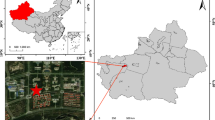Abstract
Emissions of volatile organic compounds (VOCs) are most frequent environmental nuisance complaints in urban areas, especially where industrial districts are nearby. Unfortunately, identifying the responsible emission sources of VOCs is essentially a difficult task. In this study, we proposed a dynamic approach to gradually confine the location of potential VOC emission sources in an industrial complex, by combining multi-path open-path Fourier transform infrared spectrometry (OP-FTIR) measurement and the statistical method of principal component analysis (PCA). Close-cell FTIR was further used to verify the VOC emission source by measuring emitted VOCs from selected exhaust stacks at factories in the confined areas. Multiple open-path monitoring lines were deployed during a 3-month monitoring campaign in a complex industrial district. The emission patterns were identified and locations of emissions were confined by the wind data collected simultaneously. N,N-Dimethyl formamide (DMF), 2-butanone, toluene, and ethyl acetate with mean concentrations of 80.0 ± 1.8, 34.5 ± 0.8, 103.7 ± 2.8, and 26.6 ± 0.7 ppbv, respectively, were identified as the major VOC mixture at all times of the day around the receptor site. As the toxic air pollutant, the concentrations of DMF in air samples were found exceeding the ambient standard despite the path-average effect of OP-FTIR upon concentration levels. The PCA data identified three major emission sources, including PU coating, chemical packaging, and lithographic printing industries. Applying instrumental measurement and statistical modeling, this study has established a systematic approach for locating emission sources. Statistical modeling (PCA) plays an important role in reducing dimensionality of a large measured dataset and identifying underlying emission sources. Instrumental measurement, however, helps verify the outcomes of the statistical modeling. The field study has demonstrated the feasibility of using multi-path OP-FTIR measurement. The wind data incorporating with the statistical modeling (PCA) may successfully identify the major emission source in a complex industrial district.











Similar content being viewed by others
References
Blackwood TR (2000) An evaluation of flare combustion efficiency using open-path Fourier transform infrared technology. J Air Waste Manag Assoc 50(10):1714–1722
Carter RE, Thomas MJ, Marotz GA, Lane DD, Hudson JL (1992) Compound detection and concentration estimation by open-path Fourier transform infrared spectrometry and canisters under controlled field conditions. Environ Sci Technol 26(11):2175–2181
Chang SY, Wu CF (2012) Evaluating the performance of the horizontal radial plume mapping technique for locating multiple plumes. J Air Waste Manag Assoc 62(11):1249–1256
Eklund B (1999) Comparison of line and point source releases of tracer gases. Atmos Environ 33:1065–1071
Goldsmith CD, Chanton J, Abichou T, Swan N, Green R, Hater G (2012) Methane emissions from 20 landfills across the United States using vertical radial plume mapping. J Air Waste Manag Assoc 62(2):183–197
Guo H, Wang T, Louie PK (2004) Source apportionment of ambient non-methane hydrocarbons in Hong Kong: application of a principal component analysis/absolute principal component scores (PCA/APCS) receptor model. Environ Pollut 129(3):489–498
Hashmonay RA, Natschke DF, Wagoner K, Harris DB, Thompson EL, Yost MG (2001) Field evaluation of a method for estimating gaseous fluxes from area sources using open path Fourier transform infrared. Environ Sci Technol 35(11):2309–2313
Hunt RN, Fuchs PA (1995) Applications in continuous monitoring of atmospheric pollutants by remote sensing. Proc SPIE 2365
Lin C, Liou N, Sun E (2008) Applications of open-path Fourier transform infrared for identification of volatile organic compound pollution sources and characterization of source emission behaviors. J Air Waste Manag Assoc 58(6):821–828
Russwurm GM, Kagann RH, Simpson OA, Mcclenny WA, Herget WF (1991) Long-path FTIR measurements of volatile organic compounds in an industrial setting. J Air Waste Manag Assoc 41(8):1062–1066
Sung LY, Shie RH, Lu CJ (2014) Locating sources of hazardous gas emissions using dual pollution rose plots and open path Fourier transform infrared spectroscopy. J Hazard Mater 265:30–40
USEPA (2006) Optical remote sensing for emission characterization from non-point sources. USEPA, Research Triangle Park
Wu CF, Chen CH, Chang SY, Chang PE, Shie RH, Sung LY, Yang JC, Su JW (2008) Developing and evaluating techniques for localizing pollutant emission sources with open-path Fourier transform infrared measurements and wind data. J Air Waste Manag Assoc 58(10):1360–1369
Wu CF, Lin SC, Yeh CK (2012) Locating pollutant emission sources with optical remote sensing measurements and an improved one-dimensional radial plume mapping technique. J Environ Monit 14(4):1203–1210
Wu CF, Wu TG, Hashmonay RA, Chang S-Y, Wu YS, Chao CP, Hsu CP, Chase MJ, Kagann RH (2014) Measurement of fugitive volatile organic compound emissions from a petrochemical tank farm using open-path Fourier transform infrared spectrometry. Atmos Environ 82:335–342
Acknowledgments
The authors would like to express their gratitude to the funding provided by the Taiwan Environmental Protection Administration (TEPA) and the administrative support from the Taichung City Environmental Protection Bureau (TCEPB).
Author information
Authors and Affiliations
Corresponding author
Additional information
Responsible editor: Philippe Garrigues
Rights and permissions
About this article
Cite this article
Chang, PE.P., Yang, JC.R., Den, W. et al. Characterizing and locating air pollution sources in a complex industrial district using optical remote sensing technology and multivariate statistical modeling. Environ Sci Pollut Res 21, 10852–10866 (2014). https://doi.org/10.1007/s11356-014-2962-0
Received:
Accepted:
Published:
Issue Date:
DOI: https://doi.org/10.1007/s11356-014-2962-0




